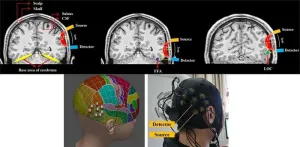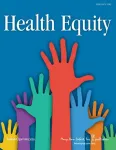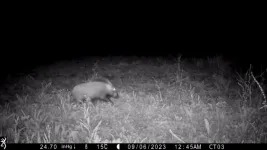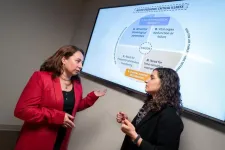Nutrition needs drive bee appetites
New research findings may help to boost pollinator health, resilience
2024-01-08
(Press-News.org) FORT COLLINS, Colo., Jan. 8, 2024 — What’s all the buzz about? Most garden enthusiasts know that certain flowers can attract pollinators. New research helps explain why, and also provides more details about how the nutrition found in plant pollen may determine which specific bee communities might favor your garden. On a larger scale, this research may help fight against pollinator declines through better design of rangeland restoration projects.
Scientists at the USDA Forest Service’s Rocky Mountain Research Station and the University of Nevada, Reno studied the foraging habits of wild bees. Their findings, published today in the Proceedings of the National Academy of Sciences, can help guide seed and plant choices that support and enhance wild bee populations. In short, their research showed that different bee species have different nutritional needs. Given that not all pollens are the same, bees forage accordingly to meet their unique needs.
“Nutrition is widely recognized as a key factor in addressing pollinator declines, and plants vary in the protein and lipid content of the pollens they offer to bees,” said lead author Dr. Anthony Vaudo, a research biological scientist at RMRS. While nectar also provides nutrients, Vaudo focused on pollen nutrition because larvae are dependent on pollen for development.
“We wanted to bring focus to that aspect of nutrition and foraging and its direct effects on the health of the developing bees,” he added.
Researchers sampled the proteins and lipid content of the pollens of 109 plant species in the Great Basin region that generally bloom in the same area at about the same time, providing a snapshot of the nutritional landscape. The team observed the patterns of 75 varieties of pollen-collecting bees and found that the nutritional content of pollens in plant communities predicted which bee communities the plants would attract.
They determined plants within related genera can offer similar pollen nutrition and are functionally similar for bees. This information may be used to predict how a bee may choose a different host plant in a new environment. The research team also found that many bees do not have allegiance to a particular plant family or genus, and that there was a more basic nutritional reason which plants bees preferred. The research has particular relevance for the selection of seeds used for conservation of bee habitat and plant communities.
Vaudo said, “This has exciting opportunities for future restoration research and could change the way bee communities can be conserved or improved. For example, designing a restoration project with more nutritionally diverse plants and testing to see if they attract more bees or a higher diversity of bees.” He added, “One interesting feedback loop is that increased pollination can lead to increased seed production. This idea of nutritional diversity can support healthier bee populations and hopefully provide resilience in changing environments.”
Vaudo credits his co-authors from the Department of Biology at the University of Nevada, Reno for their critical contributions to the project. Dr. Anne Leonard’s background in behavioral studies provided the “bee perspective” and consideration of community behavior, and Dr. Lee Dyer developed appropriate statistics to analyze the data.
About USDA Forest Service Rocky Mountain Research Station
The Rocky Mountain Research Station is one of five Forest Service research stations serving federal and state agencies, international organizations, Tribes, academia, non-profit groups, and the public. RMRS researchers work in a range of biological, physical, and social science fields to promote sustainable management of the nation's diverse forests and rangelands. The station develops and delivers scientific knowledge and innovative technologies with a focus on informing policy and land-management decisions. Working out of 15 laboratories across the Western U.S., RMRS researchers work in collaboration with a range of partners, including other agencies, academia, nonprofit groups, and industry.
END
[Attachments] See images for this press release:
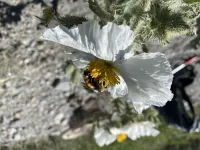
ELSE PRESS RELEASES FROM THIS DATE:
2024-01-08
The brain is not only the most complex organ of the human body, but also one of the most difficult to study. To understand the roles of different regions of the human brain and how they interact, it is crucial to measure neuronal activity with awake subjects while they perform controlled tasks. However, the most accurate measurement devices are invasive, which greatly limits their use on healthy humans in real-life settings.
To overcome this major obstacle, scientists have come up with ingenious techniques to measure brain activity in safe and ...
2024-01-08
INDIANAPOLIS—Researchers at Indiana University School of Medicine are using a novel approach to hopefully develop a new therapy for glaucoma, a complex disease that eventually leads to blindness, thanks to a new five-year, $2 million R01 grant from the National Eye Institute.
“Glaucoma is a silent, underdiagnosed, costly and debilitating disease,” said Tasneem Sharma, PhD, assistant professor of ophthalmology and lead investigator on the project. “It occurs when there is ...
2024-01-08
In the Roundtable titled “A Glimpse at How Stakeholders Are Working Towards Achieving Health Equity,” published in the peer-reviewed journal Health Equity, two expert panel discussions examine efforts to achieve maternal health equity and changes that health systems can make to operationalize health equity. Click here to read the Roundtable now.
The moderator of the panel discussion titled “Efforts to Achieve Maternal Health Equity Today” is Laurie Zephyrin, MD, MPH, MBA, Senior Vice President, Advancing Health Equity, The Commonwealth Fund. The discussion focuses on what health systems can ...
2024-01-08
Embargoed until 1 p.m. CT/2 p.m. ET Monday, Jan. 8, 2024
DALLAS, Jan. 8, 2024 — From humble beginnings as a small professional health society formed by six cardiologists in Chicago in 1924, the American Heart Association has emerged as the nation’s oldest and largest voluntary organization dedicated to fighting heart disease and stroke. Uniting more than 35 million volunteers and supporters and more than 2,900 employees, the Association today is a global force transforming the way the world understands, treats and prevents cardiovascular and cerebrovascular ...
2024-01-08
In social media posts on the community network Reddit, users reported reduced cravings for alcohol when taking drugs intended to treat Type 2 diabetes and obesity.
Across a number of threads — with titles such as “Did scientists accidentally invent an anti-addiction drug?” and “I don't know if this is a side effect but ... Mounjaro makes me drink less!!!!!” — users reported a changing relationship with beer, wine, and liquor.
An analysis of those posts, together with a remote study of individuals with obesity who reported using semaglutide ...
2024-01-08
Thanks to technological advances, scientists have access to vast amounts of data, but in order to put it to work and draw conclusions, they need to be able to process it.
In research recently published in Genome Biology, Rensselaer Polytechnic Institute’s Boleslaw Szymanski, Ph.D., Claire and Roland Schmitt Distinguished Professor of Computer Science and director of the Network Science and Technology Center, and team have found a method that effectively organizes and groups the data for a variety of applications. The process is referred to as clustering ...
2024-01-08
Researchers from the Harvard John A. Paulson School of Engineering and Applied Sciences (SEAS) have developed a new lithium metal battery that can be charged and discharged at least 6,000 times — more than any other pouch battery cell — and can be recharged in a matter of minutes.
The research not only describes a new way to make solid state batteries with a lithium metal anode but also offers new understanding into the materials used for these potentially revolutionary batteries.
The research is published in Nature Materials.
“Lithium metal anode batteries are considered the holy grail ...
2024-01-08
Andalibi To Receive Funding For Perthera Tissue Bank
Ali Andalibi, Senior Associate Dean, College of Science, is set to receive funding for: "Perthera Tissue Bank."
FFPE samples from Perthera will be housed in the cold room in the Institute for Advanced Biomedical Research (IABR). The Principal Investigator, Co-Investigator, and the staff member will be checking on the samples on a regular basis to ensure that the samples are safely stored and that the storage conditions, such as temperature, are appropriate. ...
2024-01-08
In the ongoing biodiversity crisis, large terrestrial animals are more threatened by extinction than any other group of organisms. The African continent holds an impressively intact large-mammal community, but there is still a lot we do not know about how these species evolved, became diverse and adapted to the changing climate and habitats. Many of these questions can be addressed by investigating the genomes and genetic variation across species.
New research, published in Nature Communications, uses genomics to answer ...
2024-01-08
(MEMPHIS, Tenn. – January 05, 2023) St. Jude Children’s Research Hospital investigators collaborated with a global group of acute pediatric critical illness experts to reach a consensus definition of the condition. Research on how to improve care in low- and middle-income countries has been stymied because conventional pediatric critical illness definitions are not applicable in these settings. The new, more universal definition, reached by consensus among researchers and clinicians from 40 countries, will enable scientists to study pediatric critical illness more universally, which should lead to improvements in patient outcomes ...
LAST 30 PRESS RELEASES:
[Press-News.org] Nutrition needs drive bee appetites
New research findings may help to boost pollinator health, resilience

